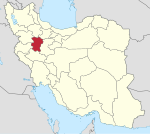|
Dargazin, Hamadan
Dargazin (Persian: درگزین)[a] is a village in, and the capital of, Dargazin-e Sofla Rural District[5][b] of the Central District of Dargazin County, Hamadan province, Iran. HistoryIn the 11th century, the Darjazin area had a significant population of Mazdakis and the related Khorramites.[6] The Dargazini family of viziers was also from the area.[6] The 14th-century author Hamdallah Mustawfi described Darjazin (as Darguzīn) as previously "merely a village of the A‘lam district" that had become "a provincial capital" by his lifetime.[7] He wrote that it had good agricultural lands that produced grain, cotton, grapes, and other fruits.[7] Its population, he said, were devout Sunnis of the Shafi'i madhhab (i.e. the Shafi'i sub-school of Islam) who followed the Shaykh al-Islam Sharaf ad-Din Darguzini.[7] The revenue of Darguzin, he wrote, was 12,000 dinars.[7] The Ottoman traveller Evliya Çelebi passed through Darjazin in 1654 and left a description of the town's layout, as well as its garrison and fort.[6] Evliya associated the fort with an unspecified Sasanian king named Yazdegerd, which possibly refers to Yazdegerd I.[6] No traces of the fort survive today.[6] By the time of Evliya's visit, Darjazin's population had become Shi'i; he described the Moharram mourning rites observed here.[6] In the 1700s, Darjazin became contested between Iran and the Ottoman Empire.[6] DemographicsPopulationAt the time of the 2006 National Census, the village's population was 2,629 in 689 households, when it was in Darjazin-e Sofla Rural District[c] of the former Qorveh-ye Darjazin District of Razan County.[8] The following census in 2011 counted 1,345 people in 396 households.[9] The 2016 census measured the population of the city as 1,331 people in 406 households.[2] After the census, the district was separated from the county in the establishment of Dargazin County. The rural district was transferred to the new Central District and renamed Dargazin-e Sofla Rural District.[3] ShrineThe shrine of Emamzadeh Azhar in Darjazin is dated to the Ilkhanid era; it may be the tomb of either Shaykh Salman 'Aref Dargazini (13th century) or the above-mentioned Sharaf ad-Din Dargazini (14th century).[6] The shrine itself has a circular tower with a conical dome that reaches 12 m off the ground at its highest point.[6] There is a wooden chest in the shrine which bears the date 1056 AH, or 1646 CE; part of the chest is missing.[6] Notes
References
|
||||||||||||||||||||||||

